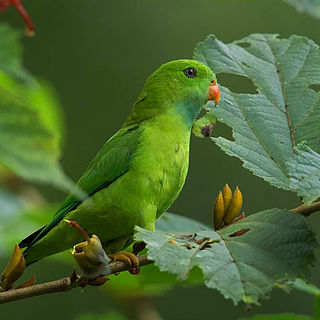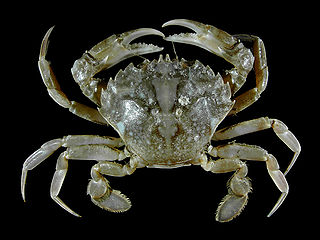
The vernal hanging parrot is a small parrot which is a resident breeder in the Indian subcontinent and some other areas of Southeast Asia. It undergoes local movements, driven mainly by the availability of the fruit, seeds, buds and blossoms that make up its diet. They frequent the banyan tree for the fruit and plantain trees for the nectar from the flowers.

The smooth green snake is a species of North American nonvenomous snake in the family Colubridae. The species is also referred to as the grass snake. It is a slender, "small medium" snake that measures 36–51 cm (14–20 in) as an adult. It gets its common name from its smooth dorsal scales, as opposed to the rough green snake, which has keeled dorsal scales. The smooth green snake is found in marshes, meadows, open woods, and along stream edges, and is native to regions of Canada, the United States, and northern Mexico. A non-aggressive snake, it seldom bites and usually flees when threatened. It mates in late spring to summer, and females lay their eggs from June to September. The smooth green snake will often bob its head in order to mimic vegetation blowing in the wind.

Adonis vernalis, known variously as pheasant's eye, spring pheasant's eye, yellow pheasant's eye and false hellebore, is a perennial flowering plant in the buttercup family Ranunculaceae. It is found in dry meadows and steppes in Eurasia. More specifically, this plant grows in a wide range of locations which include open forests, forest clearings, dry meadows, mesic steppe, and mostly calcareous soil. Isolated populations are found from Spain in the west across Central Europe with fine examples in Valais, Switzerland, and southern Europe, reaching southern Sweden in the north and Abruzzo in the south, with its main area of distribution being the Pannonian Basin and the West Siberian Plain. In contrast to most other European Adonis species, the flowers appear in springtime, and are up to 80 mm (3.1 in) in diameter, with up to 20 bright yellow petals. Not only do the flowers begin to grow, but so do the plants aerial organs, from around April to May.

Opheodrys is a genus of small to medium-sized nonvenomous colubrid snakes commonly referred to as green snakes. In North America the genus consists of two distinct species. As their common names imply, the rough green snake has keeled dorsal scales, whereas the smooth green snake has smooth dorsal scales.

Pulsatilla vernalis is a species of flowering plant in the family Ranunculaceae, native to mountainous habitats in Europe. Growing to 10 cm (4 in) high and wide, it is a semi-evergreen perennial with hairy, divided leaves. In early spring it bears anemone-like flowers which are up to 6 cm (2 in) in diameter, white flushed with violet on the outer surface of the petals, and prominent yellow stamens.

Liocarcinus vernalis, the grey swimming crab, is a small, shallow-water crab in the family Portunidae. L. vernalis was thought for a long time to be a predominantly Mediterranean species, but its known range was extended by a series of observations in the 1980s and 1990s. It ranges from West Africa to the southern North Sea.

Senecio vernalis is one of the European species of Senecio, an annual that is also known as eastern groundsel. While it has been long classified as Senecio vernalis, this species has more recently been described as a subspecies of Senecio leucanthemifolius and is now included by some in that species.
Retimohnia acadiana is a species of sea snail, a marine gastropod mollusk in the family Retimohniidae, the true whelks and the like.
Retimohnia glypta is a species of sea snail, a marine gastropod mollusk in the family Retimohniidae, the true whelks and the like.

Plicifusus is a genus of sea snails, marine gastropod mollusks in the family Buccinidae, the true whelks.
Retimohnia is a genus of sea snails, marine gastropod mollusks in the family Retimohniidae, the true whelks and the like.
Retimohnia bella is a species of sea snail, a marine gastropod mollusc in the family Retimohniidae, the true whelks and the like.
Retimohnia frielei is a species of sea snail, a marine gastropod mollusc in the family Retimohniidae, the true whelks and the like.
Retimohnia lussae is a species of sea snail, a marine gastropod mollusc in the family Retimohniidae, the true whelks and the like.
Retimohnia mcleani is a species of sea snail, a marine gastropod mollusc in the family Retimohniidae, the true whelks and the like.
Retimohnia micra is a species of sea snail, a marine gastropod mollusc in the family Retimohniidae, the true whelks and the like.
Retimohnia robusta is a species of sea snail, a marine gastropod mollusc in the family Retimohniidae, the true whelks and the like.
Retimohnia sordida is a species of sea snail, a marine gastropod mollusc in the family Retimohniidae, the true whelks.

Palola is a genus of polychaetes belonging to the family Eunicidae.
The Retimohniidae are taxonomic family in the superfamily Buccinoidea of large sea snails, often known as whelks and the like.








